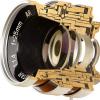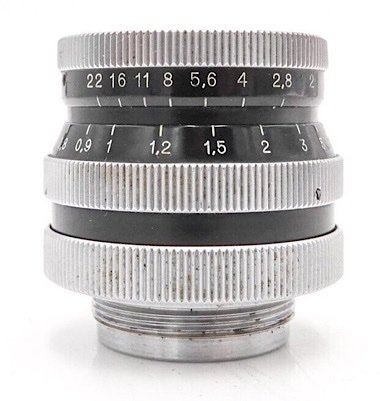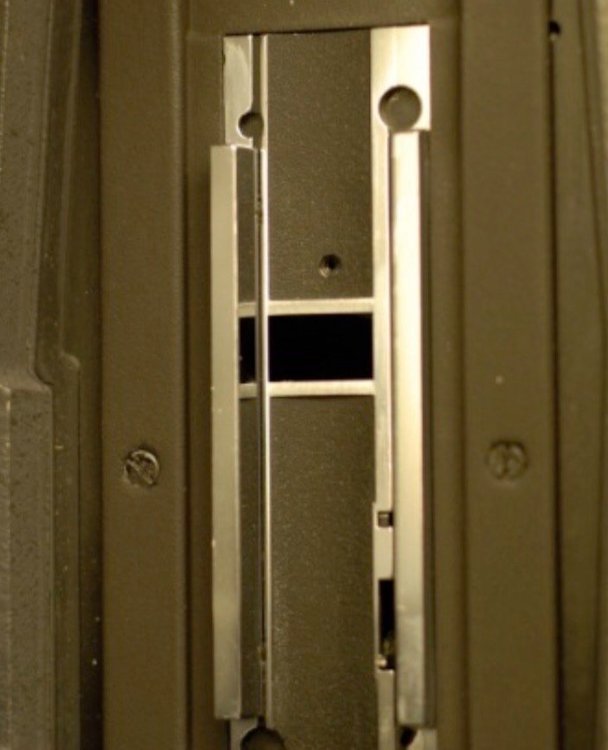-
Posts
3,512 -
Joined
-
Last visited
Everything posted by Dom Jaeger
-

Cooke Varotal 25-250mm MKI service question
Dom Jaeger replied to bj's topic in Lenses & Lens Accessories
Yeah that’s not an easy lens to work on. The entire zoom group mechanism removes from the rear, not the front, and it’s a complex beast that is tricky to reassemble and calibrate even for an experienced lens tech with a lens projector and a collimator, let alone a novice. But if you don’t mind destroying a lovely vintage optic as a learning experience, I guess go ahead. -

Cooke Varotal 25-250mm MKI service question
Dom Jaeger replied to bj's topic in Lenses & Lens Accessories
Do you have experience working on cine lenses? -
You will need the right screws too, the ones for a PL mount are a bit longer than the ones for a B mount. If memory serves you need something around 6mm long I think. The head needs to be quite small to fit inside the recessed hole as well. Original Zeiss mount screws are your best option. Perhaps Samuel kept the screws with his mounts? Otherwise try the sources I listed before.
-

T-Stop Suggestions for 16mm Film?
Dom Jaeger replied to Daniel Shevchuk's topic in Camera Assistant / DIT & Gear
Your lens aperture is a tool, any stop is useable really but it will affect your depth of field, which is one of the choices you can make as a cinematographer to tell your story. Your shallowest depth of field occurs at wide open, and at close focus distances. This helps isolate your subject from the background. But wide open is also where a lens exhibits most of its character, meaning the aberrations that are created - things like spherical or chromatic aberration, halation around highlights or veiling glare that reduces your contrast. These are artistic choices you can make regarding your image. Testing before a shoot is a good way to see how a lens performs wide open. As you stop down the image will clean up, and your depth of field will increase. If all you care about is a clean, sharp image, then shoot between around 5.6 and 11. Stopped down past that and your lens will begin to soften again, due to an optical effect known as diffraction. The zoom you mention (I assume you mean a Zeiss 10-100 T3) is a Standard 16 zoom which is pretty sharp but does not have very close focus capabilities, which might be useful to have in a small room. Just something to consider if you plan on doing close-ups or want a claustrophobic feeling etc. -
If you can source the right Bayonet mounts (with 8 screw holes in the base) then yes you can convert them to B mount. The first generation S16 Super Speeds (I call those Mk1, some call them B Speeds) used an earlier Bayonet mount with a single locating slot and a locking ring - those mounts won’t fit later Super Speed versions. You may need to adjust the shimming, best to have a tech check the back-focus after conversion.
-

Switar non reflex lens on C mount camera
Dom Jaeger replied to Patrick Cooper's topic in Lenses & Lens Accessories
You want to shoot 1000 fps on 16mm? I hope you have a stack of film.. you’ll go through a 400 ft roll in 1.6 seconds! You really need to time the shot perfectly. One of the first things to go digital was high speed cinematography, for good reason I think. But don’t let me put you off if that’s what you want to do. -

The current state of 16mm shooting in Australia
Dom Jaeger replied to Patrick Cooper's topic in Film Stocks & Processing
The figure is to build a studio, not to make a single movie. A good quality studio attracts big productions, bringing in potentially billions, and gives employment to many locals while raising the skill level of our crews and our broader film industry workers in general. Currently our largest studios are on the Gold Coast. Lovely place, but culturally a little .. monochrome. Another hub around the northern NSW area would be fantastic. -

Can i replace the J bar for the T bar in Arriflex SR2?
Dom Jaeger replied to Jonathan Galindo's topic in ARRI
You don’t want to take any screw out, you need to loosen the outer lock nut half a turn, then use an Allen driver to turn the inside screw counter-clockwise. The inside screw is actually a worm gear that will slowly undo the lock ring holding on the viewfinder. To loosen the lock nut at the start, you need a two-prong screwdriver. -

The current state of 16mm shooting in Australia
Dom Jaeger replied to Patrick Cooper's topic in Film Stocks & Processing
The last big lab in Australia, Deluxe, closed in April 2013. In November 2013 Neglab re-opened, a much smaller operation, basically one guy. So we were without any processing facilities (outside of Super 8 or home development with Lomo tanks) for about half a year. But no major features have been shot on film in this country since Deluxe closed. We have a pretty small film industry that manages to punch considerably above our weight, but once the infrastructure for supporting large film productions was fully dismantled (and actually destroyed - Deluxe ordered their staff to trash their equipment to prevent any rival labs from possibly competing with them), the days of shooting film for major movies here was over. We don’t have the volume of work to justify re-investing at that scale. We’re lucky to have Neglab still doing an excellent job, but they are really the only dedicated 16/35 cine film lab here, and they’re small. I know there have been plenty of features made here over the last decade whose directors or DoPs explored the option to shoot film but changed their minds after investigating the logistics. Just recently Nitram, and Judy and Punch come to mind for example. That doesn’t mean we don’t shoot film here though. There are actually plenty of little indie productions going on all the time, and a thriving artist film community, particularly here in Melbourne. We have world-famous experimental filmmakers like Richard Tuohy and Dianna Barrie working exclusively with film who tour the world showing their films and giving workshops. We have rental houses like Cameraquip and Panavision who have good inventories of film gear, and a number of decent film scanning options. Among younger filmmakers there’s a real interest in analogue processes, which is a world-wide movement really. As possibly the last movie camera tech still actively servicing cameras in this country I‘ve been swamped with work over the last few years. It may prove to be a temporary fad, or it may solidify into a sizeable niche market, I’m hopeful it will be the latter. By the way, if you (or anyone) can get Mark Kenfield to shoot a music vid for you on 16mm, it will be fantastic. His work is extraordinary! -

Can i replace the J bar for the T bar in Arriflex SR2?
Dom Jaeger replied to Jonathan Galindo's topic in ARRI
Sure, it’s very straightforward to change viewfinders. Are you asking if you can do it yourself? -

Switar non reflex lens on C mount camera
Dom Jaeger replied to Patrick Cooper's topic in Lenses & Lens Accessories
The flange is the flat ring where the lens seats on to the camera, at the base of the C mount thread. There is a mating flange on the camera, hence the terms flange depth or focal flange distance to describe the distance from this point to the film plane. If you have Vernier calipers you can check yourself how much depth you have on any particular C mount camera from the flange to the protective baffle or first internal surface inside. On some cameras you don’t have much room before you hit a reflex mirror or prism. 4mm is a safe protrusion depth, sometimes you can have more. Non-reflex cameras tend to have more room. -

Switar non reflex lens on C mount camera
Dom Jaeger replied to Patrick Cooper's topic in Lenses & Lens Accessories
Optically, yes they will be fine. Be careful however of older 25mm AR Switars that have a very deep C mount thread protrusion. I’m not sure exactly, but I think it tends to be serial numbers under about 250000. Both the f1.4 and f/1.5 versions. They look like this: If you screw one of these with enough force into a Beaulieu R16 or 4008 or an Eclair ACL or a reflex Bolex, you risk damaging the camera, in some cases catastrophically. Always check that the C mount protrusion of any lens used with these cameras is no more than about 4mm past the flange. You can actually use RX lenses on C mount cameras that are not reflex Bolexes. You will simply get more aberrations than usual at wide open apertures. Some will be worse than others, but generally closed down a few stops or more they should be ok. At f/5.6 or 8 I doubt you’d see any difference at all. -
I still work on them occasionally, but I prefer to work on 16mm and 35mm cameras. The Beaulieu 4008 is the only Super 8 camera I will work on these days.
-
You can actually use RX lenses on cameras that are not reflex Bolexes, but at wide apertures you will get aberrations that will make the images a bit soft and hazy. If you stop an RX lens down three stops or more from wide open, the aberrations will be far less noticeable. Test your Switar out, you may be pleasantly surprised. Any brand of sewing machine oil, or clock oil, should be fine.
-

Focal Lengths of 1930s/40s Hollywood
Dom Jaeger replied to Alexander Nowak's topic in Lenses & Lens Accessories
Some of the dates in that article, as well as on Cooke’s website, are not correct. After a lot of research I dated the first 18mm Cooke Speed Panchro to 1954, a few years after Angenieux released their 18.5mm in 1951. -
Do they make noise when run with film? SR3 mags are noisier without film, they need the tension to run properly. You could put a drop of oil in the rollers that press against the film if that’s what is squeaking. Otherwise leave it to a tech. There are no service manuals really, just exploded diagrams and basic instructions for simple maintenance procedures. Most of the knowledge was passed from tech to tech, or from training sessions at Arri back in the day. If you still think they need a service, try Cine Facilities in Amsterdam. Or any rental house near you that rents film movie cameras should have either a service department or a company that they use, ask them.
-

Vintage Angenieux 6.5-52mm teardown HELP!
Dom Jaeger replied to Casey McCoy's topic in Lenses & Lens Accessories
I hope you took lots of photos and noted each element orientation etc. Without a collimator getting the focus marks lined up could be tricky, but I assume this is a mostly a learning exercise? These are quite amazing little zooms for Standard 8mm. The back-focus would need to be accurate to within 0.01mm to keep the zoom parfocal. I imagine the zoom and focus halves of the lens need to be separated in order to release the focus ring towards the back, though this is just a guess. Often lenses are puzzles you need to unlock. There could be hidden set screws under the ring, accessible only through a hole, or maybe a lock ring somewhere. You probably need to remove the zoom cam ring. -
Your fitted gate is very odd, it has one older rail on the right and one newer one on the left, and the locating slot is not where it normally is in my experience. Definitely a weird modded gate. The gate you show on the left is not an SR3 gate, but a S16 SR2 gate. The position of the locating slot is where it normally is for SR3s and later SR2s. I suspect your camera is an older camera that has been a bit Frankensteined. An SR3 gate looks like this:
-

Vignette problem vintage lens on super35 sensor
Dom Jaeger replied to Filip Aladdin's topic in Camera Operating & Gear
All cine zooms are designed to be parfocal. If yours is not holding focus, chances are the back-focus needs adjustment. Take it to a lens tech for assessment. -

C-Mount Navitar lens with Reflex Bolex - how can I adapt?
Dom Jaeger replied to Leanna Kaiser's topic in 16mm
Any regular C mount lens will work on a reflex Bolex, the issue is just that wider focal lengths (50 mm and under) can be optically affected by the reflex prism and the image will have some aberrations, making things a bit soft and bloomy. Generally, the aberrations are reduced if you stop down to f/3.5 and beyond. The only other thing to watch out for is if the C mount thread is too long. If the threaded part (or the optics) protrude back more than about 4 mm it won’t screw in all the way on a reflex Bolex and might even damage the prism if you force it. If a lens doesn’t seat properly it will act like a macro lens and only focus very close. There is no real solution to this, you just need to avoid lenses with a long C mount thread. -
This is bad advice, there are definitely cine lenses that are not compatible with an SR3. The main culprits are certain older Arri Standard mount lenses that were made for the Arriflex 16S, like Cooke Kinetals and some Schneiders. The 16S had more mirror clearance than later cameras, so be careful with any wide angle lens in Arri Standard mount. Any lens in Arri Bayonet mount should be OK on an SR3 with a PL adapter. There are also a handful of more modern lenses that were made to be digital only, like the Angenieux DP zooms, which protrude too far back past the PL mount to fit a film camera, but from what I’ve seen most PL lenses nowadays seem to be made with film camera clearance specs in mind. Some lenses may have barrels that are too large which can foul on the SR3 viewfinder. There is a lens clearance diagram Arri provided for their 35mm spinning mirror cameras which you can use. 16mm cameras like the SR series actually have a little more clearance than the 35mm ones. The diagram is in this thread:
-
Every show we rent gear to has at least one O’Connor head per camera, they are pretty much indispensable. Geared heads have also been getting some use over the last few years, after a long time of being out of fashion, which is a welcome trend. An experienced operator on a geared head can produce lovely camera movement.
- 18 replies
-
- 2
-

-

-
- tripod
- fluid head
-
(and 2 more)
Tagged with:





